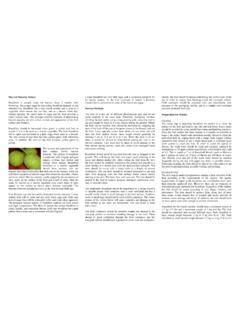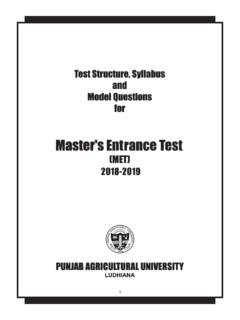Transcription of FAO statistical pocket book
1 Unit descriptionTIME PERIODS2011calendar year2011*closest to year 20112009/11 average for the three years cen-tred on 20101991-2011 annual period from 1991 to 2011 SYMBOLS AND UNITS hahectarekgkilogramUS$United States dollartonnemetric tonne (1000 kg)ktkilotonne (1000 tonnes)billionthousand milliontrillionthousand billionquadrillion thousand trillionkcalkilocaloriesmmmillimetremgmi lligramkm3cubic kilometrem3cubic metrekm2square kilometrem2square metremtmetric tonneGtgigatonne (109metric tonnes)LCUlocal currency unitPM10particles less than 10 m in diam-eterppmparts per million247 Metadata conceptsAgricultural production indicesThe FAO indices of agricultural productionshow the relative level of the aggregate volumeof agricultural production for each year in com-parison with the base period 1999-2001.
2 Theyare based on the sum of price-weighted quan-tities of different agricultural commodities pro-duced after deductions of quantities used asseed and feed weighted in a similar resulting aggregate represents, therefore,disposable production for any use except asseed and feed. All the indices at the coun-try, regional and world levels are calculatedby the Laspeyres formula. Production quanti-ties of each commodity are weighted by 1999-2001 average international commodity pricesand summed for each year. To obtain the in-dex, the aggregate for a given year is dividedby the average aggregate for the base period1999-2001. Since the FAO indices are basedon the concept of agriculture as a single en-terprise, amounts of seed and feed are sub-tracted from the production data to avoid dou-ble counting , once in the production data andonce with the crops or livestock produced fromthem.
3 Deductions for seed (in the case of eggs,for hatching) and for livestock and poultry feedapply to both domestically produced and im-ported commodities. They cover only primaryagricultural products destined to animal feed( maize, potatoes, milk, etc.). Processedand semi-processed feed items such as bran,oilcakes, meals and molasses have been com-pletely excluded from the calculations at allstages. It should be noted that when calcu-lating indices of agricultural, food and non-food production, all intermediate primary in-puts of agricultural origin are deducted. How-ever, for indices of any other commodity group,only inputs originating from within the samegroup are deducted; thus, only seed is removedfrom the group "crops" and from all crop sub-groups, such as cereals, oil crops, etc.
4 ; and bothfeed and seed originating from within the live-stock sector ( milk feed, hatching eggs) areremoved from the group "livestock products".For the main two livestock subgroups, namely,meat and milk, only feed originating from therespective subgroup is removed. Indices whichtake into account deductions for feed and seedare referred to as net . Indices calculated with-out any deductions for feed and seed are re-ferred to as gross . The "international com-modity prices" are used in order to avoid theuse of exchange rates for obtaining continen-tal and world aggregates, and also to improveand facilitate international comparative analy-sis of productivity at the national level.
5 These"international prices", expressed in so-called "in-ternational dollars", are derived using a Geary-Khamis formula for the agricultural sector. Thismethod assigns a single "price" to each com-modity. For example, one metric ton of wheathas the same price regardless of the countrywhere it was produced. The currency unit inwhich the prices are expressed has no influenceon the indices published. The commoditiescovered in the computation of indices of agri-cultural production are all crops and livestockproducts originating in each country. Practi-cally all products are covered, with the mainexception of fodder crops. The category of foodproduction includes commodities that are con-sidered edible and that contain nutrients.
6 Ac-cordingly, coffee and tea are excluded alongwith inedible commodities because, althoughedible, they have practically no nutritive applied to meat in reality represent theprices of animals for slaughtering in terms oflive weight. For example, if the price of onemetric ton (1000 kg) of pigs alive is 825 dollarsand the ratio meat to live weight is 75 to 100,the price applicable to 750 kg of pig meat willbe 825 dollars, corresponding to 1100 dollarsper metric tons. The indices are calculated fromproduction data presented on a calendar yearbasis. The FAO indices may differ from thoseproduced by the countries themselves becauseof differences in concepts of production, cover-age, weights, time reference of data and meth-ods of harvestedData refer to the area from which a crop is gath-ered.
7 Area harvested, therefore, excludes thearea from which, although sown or planted,there was no harvest due to damage, failure,etc. It is usually net for temporary crops andsome times gross for permanent crops. Netarea differs from gross area insofar as the lat-ter includes uncultivated patches, footpaths,ditches, headlands, shoulders, shelterbelts, the crop under consideration is harvestedmore than once during the year as a conse-quence of successive cropping ( the samecrop is sown or planted more than once in thesame field during the year), the area is countedas many times as harvested. On the contrary,area harvested will be recorded only once in thecase of successive gathering of the crop duringthe year from the same standing crops.
8 Withregard to mixed and associated crops, the areasown relating to each crop should be reportedseparately. When the mixture refers to partic-ular crops, generally grains, it is recommendedto treat the mixture as if it were a single crop;therefore, area sown is recorded only for thecrop stock in agriculture and investment inagricultureThe estimate of capital stock in agriculturerefers to a value that is attached to the totalphysical capital capacity available for repeateduse in the production of other goods, in exis-tence at specific point in time in the economy ofagriculture sector. The estimates of investmentin agriculture have indirectly been derived bythe FAO Statistics Division using physical dataon livestock, tractors, irrigated land and landunder permanent crops etc.
9 , and the averageprices for the year 1995. These data enabledthe derivation of the capital stock in agricul-ture which is the gross, and the annual change248in the latter is taken to reflect investment CIF-trade values in-clude the transaction value of the goods, thevalue of services performed to deliver goodsto the border of the exporting country and thevalue of the services performed to deliver thegoods from the border of the exporting countryto the border of the importing country. Importvalues are mostly reported as areaCrop area is a surface of land on which a cropis grown. In general, the area measured forcadastral purposes includes, in addition to thearea cultivated, headlands, ditches and othernon-cultivated areas.
10 Such an area can becalled gross area as against the net area whichincludes only the portion of the gross areaactually cultivated. For various reasons, calamities or economic considerations,certain areas planted or sown with a given cropare not harvested or are harvested before thecrop reaches maturity. Hence the need for theconcept of area to be sub-divided into sown orplanted area and harvested area. Sown areadata are necessary to estimate quantities usedfor seeding purposes; harvested area, to pro-vide reliable and accurate yield and productiondata. A peculiarity of permanent crops is thatnumber of trees or plants is reported in addi-tion to or, instead of, the area planted.
















